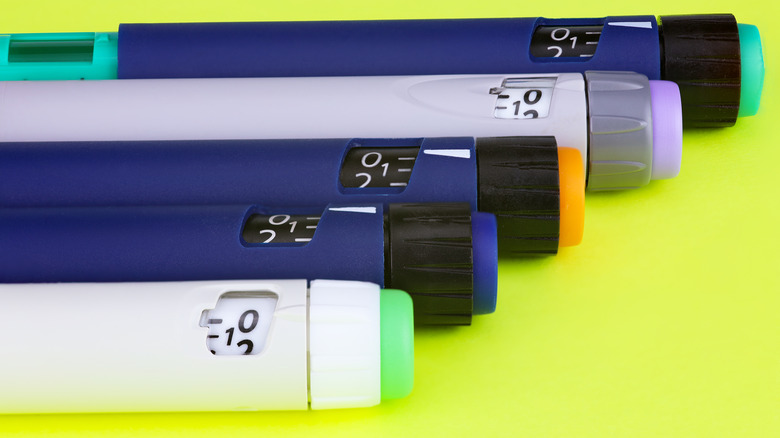Saxenda Explained: Uses, Dosage, And Side Effects
According to a study published in Frontiers in Endocrinology, excess weight or obesity happens when energy intake is higher than energy expenditure (when "calories in" exceed "calories out"). In contrast, an energy balance (eating as many calories as you burn) ensures your weight stays the same, while an energy or calorie deficit (when you eat fewer calories than you burn) facilitates weight loss (via Healthline).
However, obesity is a complex condition that results from a combination of genetic, environmental, dietary, psychological, and behavioral risk factors. Given the role these factors play in its development, researchers believe that the causes of obesity go beyond the calories you eat versus the ones you burn. Therefore, losing weight may not only be about restricting the amount of food you eat. Per the Centers for Disease Control and Prevention (CDC), about 42% of the adult American population and 20% of American children and teens have obesity. Unfortunately, statistics have shown an upward trend rise in recent years.
The U.S. Food and Drug Administration (FDA) approved Saxenda (liraglutide) in 2020 for people 12 years and older with obesity who need to manage their weight. Saxenda is an injected prescription drug that helps adults with a body mass index (BMI) of 27 and over (a.k.a. medically considered overweight or obese) and teens with a body weight over 132 pounds lose excess weight. More importantly, it claims to help keep the weight off. This article tells you all you need to know about Saxenda, including how to use it and its potential side effects.
Consequences of having excess weight
Having excess weight or obesity can really take a toll on your overall health by increasing the risk of numerous diseases. For starters, the National Institute of Diabetes and Digestive and Kidney Diseases explains that obesity can increase the risk of developing metabolic syndrome, a cluster of conditions that include high blood sugar and blood pressure, high cholesterol and triglycerides levels, low HDL (good) cholesterol levels, and a high visceral fat ratio (the fat that settles around your waistline). Whether you have one or more of these conditions, they increase your risk of developing type 2 diabetes, heart disease, and stroke.
Moreover, obesity is also a risk factor for sleep apnea, which affects your breathing while you sleep and may even lead to periods when you're not breathing at all. In addition, carrying excess weight can strain your joints and cartilage, thus increasing the chances of getting osteoarthritis or inflamed and painful joints. Also, obesity can increase the likelihood of developing certain types of cancers, as well as kidney, liver, and gallbladder diseases, and lead to pregnancy problems. Lastly, a study published in Frontiers in Endocrinology states that adults who are obese have a higher likelihood of mortality and premature death. Nevertheless, per the CDC, by losing just 5 to 10% of your total body weight, you can reduce the risk of developing obesity-related complications and lead a long and healthy life.
How does Saxenda work?
Saxenda helps you lose weight and keep it off because it acts as an appetite regulator. It reduces your hunger levels, which leads to fewer consumed calories and, ultimately, weight loss. Saxenda belongs to a class of drugs known as incretin mimetics or glucagon-like peptide-1 receptor agonists (GLP-1 RAs), meaning that they imitate the effects of the hunger-reducing hormone glucagon-like peptide-1 (GLP-1) (via Drugs.com). According to Healthline, GLP-1 RAs are commonly used to treat type 2 diabetes because of their blood sugar-lowering effects. Yet, they can also help manage your weight by slowing down gastric emptying (the rate at which your stomach empties its contents). Thus, since food is passed down slowly through your digestive tract, you get a prolonged feeling of fullness.
According to Drugs.com, you can expect Saxenda's effects to show after eight weeks of taking the medicine. While you may start losing weight by the first two weeks of treatment, you should notice a significant weight loss of 5% of your total body weight by the eighth week. Nevertheless, keep in mind that Saxenda should be used alongside a low-calorie diet and a physical activity program for you to see the desired results (per Saxenda). Also, note that Saxenda may not work for everyone. As Drugs.com explains, people who don't see a 4% body weight reduction by the 16th week of treatment may be taken off the drug.
Saxenda dosage and directions
Saxenda comes in a single-use, 18-milligram prefilled pen, and can be set to deliver doses of 0.6, 1.2, 1.8, 2.4, or 3 milligrams at a time. Saxenda is administered daily at any time, with or without food. On the first week of treatment, patients start with the lowest possible dose of 0.6 milligrams and work their way up weekly until reaching the maximum recommended or maintenance dose of 3 milligrams. Adults who don't tolerate an increased dose may delay the increase for a week. The same goes for teenagers, who may need up to eight weeks to reach the maintenance dose. Alternatively, if teens still can't tolerate the 3-milligram dose, their maintenance dose may be reduced to 2.4 milligrams per day.
Saxenda is designed to be injected under the skin of areas like your thighs, upper arms, or stomach area. Choose a different area each day to avoid the risk of cutaneous amyloidosis or lumps under your skin (via Saxenda). To inject the medication, make sure to use a new needle and check needle flow according to the medicine's instructions. Then, insert the needle into your skin without covering the dose counter with your hand and press and hold the dose button until the dose counter marks zero. Lastly, count slowly to six before removing the needle to ensure you get the full dose.
Cloudy Saxenda should be discarded, and new pens should be refrigerated. In contrast, you may refrigerate used ones or store them in a dark and cool place (via Saxenda).
How much does Saxenda cost?
The cost of Saxenda may vary depending on your insurance coverage, as specific insurance plans include Saxenda in their coverage, whereas others do not. Although the list price of Saxenda (the price set by the manufacturer before discounts or price adjustments) is $1,349.02 for each 18-milligram pen, the final cost for patients may be significantly lower depending on their prescription medication insurance coverage. However, people whose insurance policy doesn't cover Saxenda may have to pay the total list price.
Per Novocare (Saxenda's manufacturer), people with private or employer-covered insurance can expect to pay just about $25 for each pen, which should cover 30 days of treatment. Similarly, people with Veterans Affairs (VA) healthcare coverage and, in some cases, those with TRICARE coverage can also get their medication at a discounted price, as both plans provide coverage for obesity medications. When it comes to Medicaid, whether your plan covers Saxenda or not depends on each state's prescription drug coverage. Thus, you'd have to personally contact your state's Medicaid office to find out. As for people with Medicare (which doesn't cover obesity medications) or without insurance, you may check your eligibility to apply for the Saxenda Savings Offer, which may also help you get each pen for $25 or save up to $200 per box during the first year of treatment (via NovoCare).
Potential side effects
Despite Saxenda's weight loss benefits, this drug also comes with its share of potential side effects, some of which are more concerning than others. Some of the most common and milder side effects of the drug include diarrhea, constipation, nausea, vomiting, headache, tiredness, stomach pain, dizziness, fever, skin reactions on the injection site, and low blood sugar levels, which leads to shakiness, sweating, weakness, drowsiness, confusion, irritability, or hunger (per Novocare). However, the site also shares a long list of severe side effects, starting with pancreatitis or inflammation of the pancreas, which may present in the form of long-lasting stomach pain. In addition, Saxenda may lead to gallstones, tachycardia or increased heart rate, kidney failure due to severe dehydration, allergic reactions, and even an increased risk of depression and suicidal thoughts.
Moreover, Saxenda comes with a boxed warning for thyroid tumors. Per the National Library of Medicine (NIH), a boxed warning is the top safety warning assigned by the Food and Drug Administration (FDA) to warn consumers about a drug's highest possible health risks. According to Drugs.com, animal studies show that Saxenda can cause thyroid tumors depending on the dosage and duration of treatment. While research in humans is still inconclusive, the drug should not be used in people with a family history of thyroid cancer.
If you or anyone you know is having suicidal thoughts, please call the National Suicide Prevention Lifeline by dialing 988 or by calling 1-800-273-TALK (8255).
Who should not take Saxenda
According to Saxenda's instruction manual, the medication is contraindicated in people with a family history of medullary thyroid carcinoma (a type of thyroid cancer) and people with Multiple Endocrine Neoplasia syndrome type 2 (a condition that also causes thyroid tumors) due to the drug's risk of developing thyroid cancer. Additionally, given the increased risk of suicidal thoughts, Saxenda should not be prescribed to people with depression or who have tried to attempt suicide in the past.
Drugs.com explains that Saxenda may interact with other diseases and, thus, should not be the drug of choice for certain people. For example, people with a history of pancreatitis should avoid taking GLP-1 receptor agonists (GLP-1 RAs) such as Saxenda, due to the increased risk of developing pancreatitis a second time. In addition, people with renal dysfunction have a higher risk of kidney failure while taking GLP-1 RAs. Lastly, avoid taking Saxenda if you have a liraglutide allergy or are taking other liraglutide-containing medicines or GLP-1 RA. People taking Saxenda who haven't lost at least 4% of their total body weight by the 16th week of treatment should discontinue its use, as it is unlikely they'll lose a significant amount of weight or keep the weight off for a long time through continued treatment (via Saxenda).
If you or someone you know needs help with mental health, please contact the Crisis Text Line by texting HOME to 741741, call the National Alliance on Mental Illness helpline at 1-800-950-NAMI (6264), or visit the National Institute of Mental Health website.
Saxenda, pregnancy, and breastfeeding
Generally speaking, trying to lose weight during pregnancy is not advised because it increases the risk of harming the baby. Instead, it would be best to lose weight before pregnancy in the case of overweight or obesity (via Medical News Today). Moreover, while there is no available information on the risk of a Saxenda-induced miscarriage, animal studies show fetal abnormalities and early death when exposed to liraglutide (via Saxenda). Therefore, since the dangers of taking Saxenda during pregnancy are greater than the benefits, and seeing that pregnant people can manage their weight during pregnancy through different and safer strategies, you should not take Saxenda while pregnant.
As for breastfeeding, there is no information regarding the presence of Saxenda in the breast milk of people who are undergoing treatment. However, Drugs.com states that studies in rats show high concentrations of Saxenda present in the milk of rats treated with the drug during pregnancy and breastfeeding, leading to reduced weight gain in their offspring. Thus, according to the site, since it is not advised to take Saxenda while breastfeeding, your healthcare provider should guide you on whether to continue breastfeeding or continue with your Saxenda treatment, but not both.
It may interact with alcohol and other drugs
According to WebMD, drug interactions happen when you mix two different medications whose mechanisms of action clash with one another or when you combine any drug you're taking with certain foods or alcohol. In any case, drug interactions can lower your medicine's effectiveness, increase its effects to unwanted or unhealthy levels, or trigger potentially harmful side effects. Like most drugs, Saxenda can interact with other medications. In fact, per Drugs.com, it has two known major drug interactions that can lead to significant health risks (it interacts with bexarotene and gatifloxacin, a skin medication, and an antibiotic, respectively). The site lists moderate interactions with 223 other drugs and minor interactions with 26 additional medications.
Moreover, taking Saxenda with alcohol may cause hypoglycemia or dangerously low blood sugar levels in people with diabetes because both have blood sugar-lowering effects on their own. Thus, you can get a combined effect by consuming them together. Plus, since GLP-1 RAs like Saxenda slow down gastric emptying, Drugs.com recommends paying special attention to the effectiveness of drugs with low bioavailability, antibiotics or other drugs that need to reach a specific concentration to work, and painkillers or other medications that need to be absorbed quickly when consumed together with GLP-1 RAs to ensure their effects are not being blocked.
Finally, it is not known whether or how Saxenda may interact with other weight-loss products, such as herbal supplements and other prescription or over-the-counter drugs (via Saxenda).
Saxenda versus Ozempic
Like Saxenda, Ozempic (semaglutide) is a prescription weight loss medication that works by copying the effect of the hunger-reducing hormone GLP-1, meaning that they both help reduce your appetite by acting as glucagon-like peptide-1 receptor agonists (per Drugs.com). However, while they share a mechanism of action and most of their side effects, they have several differences, including their dosage, directions, and cost.
For starters, while both drugs are administered via a subcutaneous injection, Saxenda is taken once a day. In contrast, Ozempic is administered once a week. In addition, the initial dose of Saxenda is 0.6 milligrams per day, which is gradually increased to a maximum of 3 milligrams per day, whereas Ozempic starts at a 0.25-milligram dose, which is increased to 0.50 milligrams after one month of treatment, and doses of 1 and 2 milligrams (the maximum recommended dose) are only prescribed in cases needing further blood sugar control (via Drugs.com).
Moreover, Saxenda is more costly that Ozempic, with a list price of $1,349.02 per prefilled pen versus $994.86 for each Ozempic pen. Lastly, unlike Saxenda, Ozempic has yet to be approved by the Food and Drug Administration (FDA) as a weight-loss drug.
Saxenda versus Phentermine
Saxenda (liraglutide) and Phentermine are both medications used for weight loss. However, aside from their weight loss effect, they don't have much in common. On the one hand, Saxenda reduces your appetite by inhibiting hunger-reducing hormones, while Phentermine is a Central Nervous System (CNS) stimulant and anorexiant that suppresses appetite by acting on the parts of your brain that control hunger and satiety (via Drugs.com). Moreover, Saxenda is administered via a daily subcutaneous injection, while Phentermine is usually taken once or three times a day orally as a tablet or capsule around your meals.
In addition, Saxenda is designed as a long-term weight-reduction treatment (via Saxenda). In contrast, since Phentermine can be habit-forming (meaning that it can lead to dependency or addiction) and because its weight-loss effects wear off after a while, it is only prescribed as a short-term weight-loss solution (via Drugs.com). Lastly, Saxenda and Phentermine have different side effect profiles. Saxenda can cause nausea, vomiting, diarrhea, and constipation. In contrast, Phentermine can cause dry mouth, insomnia, anxiety, and high blood pressure (via Drugs.com). While both drugs may help you achieve your weight loss goals, it is important to consult with a healthcare provider to determine which medication is appropriate for your individual needs.
Alternatives to Saxenda
There are numerous different therapeutic approaches when it comes to tackling obesity, some less invasive than others. Healthline lists dieting, exercise, lifestyle changes, medications, and surgery as common treatment options. The best weight-loss diets are the ones that reduce your total calorie intake while still being sustainable in the long run. Similarly, whether you choose to swim, jog, or join a resistance-training class, a successful exercise program is one that you enjoy doing, as this will make you more likely to stick with it in the long run rather than quitting after the first few weeks.
Regarding lifestyle changes, follow simple strategies such as keeping healthy snacks at hand, drinking more water, avoiding watching T.V. while eating, reducing your fast food intake, and reading nutritional labels. Also, downloading self-monitoring weight loss apps can be of great help. In fact, according to a review in the Journal of Medical Internet Research, combining health coaching interventions with self-monitoring apps led to improved weight loss outcomes. Moreover, when it comes to weight-loss drugs, Drugs.com lists over 30 therapy options you can choose from (with the guidance of a healthcare professional) in case you're not a candidate for Saxenda.
Finally, per a review in Obesity Surgery, weight-loss or bariatric surgery is the most effective option for people with extreme obesity. There are two main types of bariatric surgeries: the ones that restrict the amount of food you can eat, and the ones that limit the number of nutrients your body can absorb (via the Mayo Clinic). Your healthcare provider can help you determine which option is more suitable for you.












